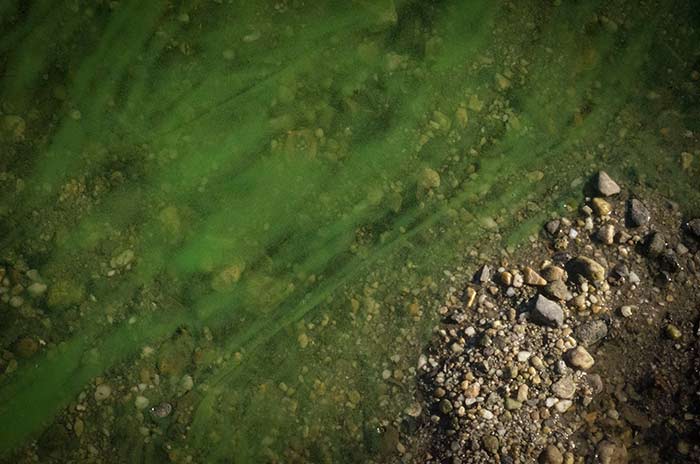
(Photo by Julie O’Connor)
Anyone in the New Paltz area within view of the Wallkill River over the last few months couldn’t help but notice the water had turned an alarming shade of neon green. Testing of the water confirmed the presence of chlorophyll-A and Microcystis bacteria registering up to 25 times the level that the state Department of Environmental Conservation (DEC) deems acceptable.
The toxic situation was documented along a 30-mile stretch of the Wallkill from Montgomery to Rifton and a portion of the Rondout Creek, affecting ten municipalities and many public access points in Orange and Ulster counties. Local points of public access to the river include the boat launch at Sojourner Truth Park on Springtown Road and the Rail Trail bridge crossing.
A public meeting was held at SUNY New Paltz last Thursday, November 3 for the purpose of educating local residents about the toxic bacterial situation and to discuss what can be done to prevent future occurrences.
Speakers included Jason West, former New Paltz mayor and current executive director of Wallkill River Watershed Alliance (WRWA); Jim Hyde, research scientist with the New York State Dept. of Health; Dr. Jillian Decker, affiliated with SUNY Rockland and a director of WRWA; Dan Shapley of Riverkeeper and WRWA; and Dr. Rebecca Gorney, a biologist with the state DEC’s division of water, lake monitoring and assessment.
Gorney explained that most of the algae found in bodies of water is not harmful, and that in fact we need some types of algae for a healthy ecosystem. But the recent concentration of organisms in the Wallkill that tested as toxic are commonly categorized as HABs, an acronym, she said, for “harmful compounds (toxins and skin irritants), algal cyanobacteria (technically not algae at all but ancient bacterial organisms that reproduce quickly) and blooms (a dense concentration in surface waters).”
The difficulty in evaluating HABs, explained Gorney, is that it’s impossible to tell just by looking at the water whether it’s toxic algal bloom or harmless algae. Testing of the water has to be done, which is expensive and time-consuming. But the hazards from contact with HABs are such that visual recognition is considered enough to avoid the situation. A visual assessment, while not the confirmation that test results bring, is still enough to warrant a beach closure, for example, even before there is time for test results to come back.
Visual clues that HABs, or blue-green algae, as it’s commonly called, is present, include strongly colored surface water (blue-green, green, yellow, white, brown, purple or red) with a paint-like appearance. Blue-green algae forms floating mats or scums on the water. If in doubt, assume it is a HAB. “If you see a bloom, it is a bloom, and you’re going to avoid contact,” said Gorney. “That is my take-home message.”
To view photographs of blue-green algae blooms, visit dec.ny.gov/chemical/81962html.
Because it is so difficult to distinguish HABs from non-harmful algae blooms, people are advised to avoid swimming, wading, boating, fishing, eating fish or drinking water with a bloom. Avoid water that is noticeably discolored and areas with blooms or surface scums present.
The toxins produced by blue-green algae can be harmful to people, pets, livestock and wildlife. Exposure may result from ingestion, skin contact or inhalation. If people or pets are exposed, they should rinse off with clean water immediately. Seek medical attention if contact results in vomiting, nausea or diarrhea; skin, eye or throat irritation; or allergic reactions or breathing difficulties.
More serious consequences of contact with blue-green algae include neurological or liver damage. The most serious symptoms are likely to result from exposure by ingestion (accidental swallowing of the water while swimming, for example). And there have been instances in the state where the bacteria has proved fatal to dogs, who ingest it while grooming after exposure.
Blue-green algae is usually found in lakes rather than rivers like the Wallkill, said Gorney, due to the way moving waters can break up the concentration of blooms. HABs prefer stagnant water, high sunlight conditions and warm temperatures like those of late summer. The microscopic organisms are hardy, able to actually move in the water, going down to the sediment to retrieve nutrients then moving up to the surface to access light. They can even convert nitrogen from the air for their use in the water.
And they thrive in high-nutrient situations. Excess nutrients in the water can come from sewage (both treated and untreated), dog waste, phosphate-containing soaps and detergents and runoff of fertilizers from farms and lawns.
Once a HAB situation is present, it has to die out on its own. But occurrences can be prevented if residents become more environmentally aware, taking steps such as having one’s septic system professionally inspected and pumped out regularly. Also helpful to the situation would be picking up after one’s dog (dog waste washed by rain into storm drains goes into streams) and reducing the use of fertilizers.
In addition to knowing what blue-green algae is and how to prevent future proliferations of it, it’s essential that people report sightings of it, as well. The more data the DEC and environmental advocates have to work with, the better they can monitor situations and prevent future outbreaks.
Photographs of suspicious algal bloom may be emailed to [email protected] or [email protected]. The Wallkill River Watershed Alliance has a Harmful Algal Bloom reporting form online at riverkeeper.org/wp-content/uploads/2016/06/Wallkill-River-Watershed-Alliance_Harmful-Algal-Bloom-Monitoring-Program.pdf.

In 1998 Basil Segos of Riverkeeper filed an “intent to sue” paper with the Village because of the open sewer pipe 200 feet south of the Carmine Liberta Bridge. The pipe is still there spewing out raw sewage, the river has turned green and Basil Segos is now head commissioner of the Department of Environmental Conservation for the State of New York.
That pipe was installed 116 years ago, and everybody acts like this is a new thing? Only the bridge is new.